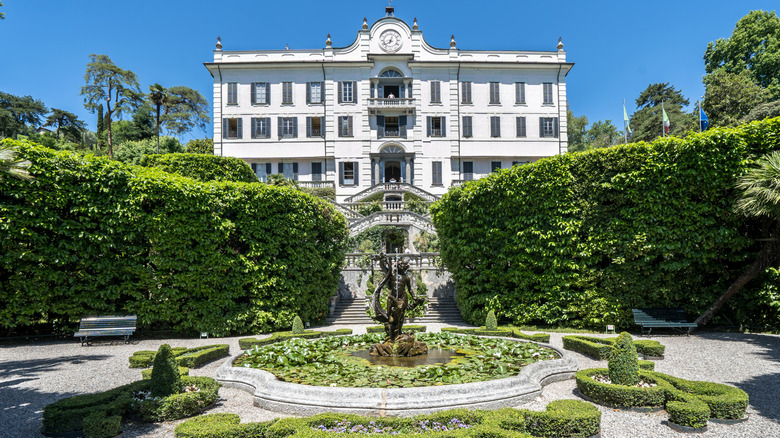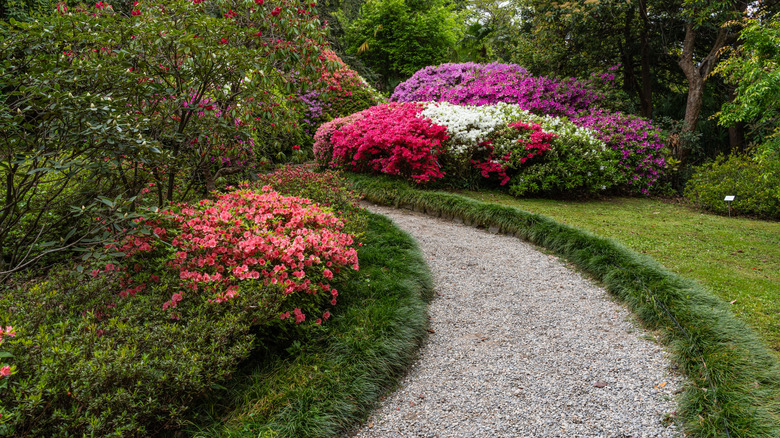Rick Steves Believes Lake Como's Pastel Pink Villa Has One Of The Best Gardens In All Of Italy
Italy always tends to spark admiration and maybe also a small grain of jealousy with its shimmering coasts, mighty Dolomite peaks, flavorful regional cuisine, and surreal lake region. It's no wonder that Rick Steves refers to the Italian Lake District as "heaven-sent" for any nature lover. Lake Como needs little to no introduction, having long enchanted visitors and inspired writers like 19th-century novelist Alessandro Manzoni with its sophisticated charm. Besides people-watching, at Lake Como you can also marvel at the grand, luxurious villas that frame the town, including one mansion that's even listed as a UNESCO World Heritage Site.
Italians constantly distinguish themselves, and another Lake Como mansion, the pastel-pink Villa Carlotta, exemplifies this. It's a place reminiscent of a fairy tale, whose grounds capture the essence of a classic Italian-style garden. Steves — the popular travel writer with itchy feet — did not let the opportunity to visit this villa slip away. And like many of us, he was struck by the meticulously preserved gardens, which he describes in his blog as "big enough to be dramatically varied, from a lush jungle canyon to this clever maze of giant azalea bushes — and all of it with million-dollar views over Lake Como." Only master gardeners would be able to create such a precious, valuable work of art! Established more than three centuries ago by Giorgio Clerici, the villa is now a museum open to the public as well as a sanctuary for garden lovers.
Steves recommends visiting Villa Carlotta in springtime, when you can stroll through the citrus-scented, tunnel-like walkways and see the brilliantly colored flowers in a collection of more than 500 plants. The villa is located in Tremezzo, a town on the western shore of the lake, across from the famous city of Bellagio. You have different options to reach the villa:you can rent a car or take a train or bus from a nearby city like Milan or you can take a ferry from the town of Como or other towns along the lake, like the undeniably romantic place known as the pearl of the lake, Bellagio.
Villa Carlotta and its flower-filled garden
Of all the villas on Lake Como, Rick Steves says in his blog that Villa Carlotta is a must-visit for garden lovers. At the entrance of the neoclassical-style villa, you're welcomed by a large water fountain with a sculpture and with water lilies floating on the surface. The fountain leads the way to the plant-embellished terraces, whose gardens follow a precise geometrical structure, with flowers dominating the scene. Maybe of all the flowers at the villa, the azaleas are the stars of the show: 150 variations of multicolored flowers, layered in kabuki-style shrubs, spread across the garden, populating a landscape that seems straight out of "Alice in Wonderland."
Then there are the Himalayan-origin rhododendrons, punctuating the garden with bright reds, along with the radiant camellias, proud symbols of devotion and care mirroring the unwavering service of workers who guard this beauty behind the scenes. The Camellia japonica is the prime type of flower in this collection, with names given to specific cultivars to honor famous personages of the Italian Risorgimento,for example the "Garibaldi" and the "Vittorio Emanuele II." Blue-purple hydrangeas also draw attention here and there, thanks to their iconic round shape.
In such a romantic and vibrant yard, roses are a must. The Harlekin rose (more passionately called the Kiss of Desire) is a bicolor white and pink rose that, along with the sweet, pale yellow Goldener Olymp rose blankets the villa's walls, providing an elegant touch. The garden also features aromatic and tropical plants: palm trees, orchids, cinnamon, clove, and patchouli. And besides flowers, if you look around and up, you'll notice soaring trees such as cypress and pine, beach trees near a bamboo grove, and Australian native fern trees.Another interesting thing to see on the grounds is the small agricultural museum inside a greenhouse, with displays of ancient tools once used to maintain the gardens.

